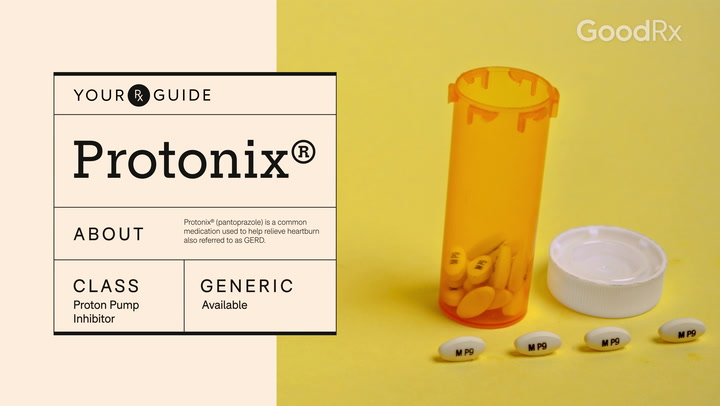
8 Protonix Side Effects You Should Know About
Key takeaways:
Protonix (pantoprazole) is part of a group of medications called proton pump inhibitors (PPIs). Protonix uses include treating gastroesophageal reflux disease (GERD) and inflammation of the esophagus (esophagitis). It’s usually well-tolerated but it can have mild side effects like headache, diarrhea, and nausea and vomiting.
More serious Protonix side effects include infectious diarrhea, kidney problems, and skin reactions. And long-term Protonix side effects can also happen, like weakened bones and vitamin deficiencies. These are more likely if you take Protonix for an extended amount of time.
It’s important to take Protonix at the lowest dose for the shortest amount of time possible. This helps minimize your risk of side effects.
There are ways to save on Protonix, which is available as both a brand-name and generic medication. GoodRx can help you find ways to save money on your prescription, with an exclusive cash price for brand-name Protonix.
Access savings on related medications
Table of contents
Proton pump inhibitors (PPIs) are a group of medications that treat digestive conditions like gastroesophageal reflux disease (GERD) and esophagus inflammation (esophagitis). Protonix (pantoprazole) is available by prescription-only and known to be effective. It’s well-tolerated in most people but still, Protonix side effects are possible. Knowing about potential Protonix side effects can help you understand what’s considered mild and manageable at home, and what’s considered more serious.
Protonix side effects at a glance
PPI side effects are usually mild, and Protonix is no exception. Typically, mild Protonix side effects include:
Headache
Diarrhea
Nausea and vomiting
Gas
Abdominal pain
Muscle pain
Dizziness
In rare cases, serious Protonix side effects can also occur, including:
Weakened bones
An infection called clostridioides difficile, or C. diff
Kidney problems
Severe skin reactions
Low vitamin B12 and magnesium levels
Stomach polyps (small growths on the inside of your stomach)
Here, we’ll discuss eight Protonix side effects you should know about.
How to take Protonix: Taking the right Protonix dosage is essential to getting the most out of your medication. Learn how to take Protonix and how long to take it for.
What to avoid with Protonix: Some foods and drinks are best avoided with Protonix. This includes foods that worsen heartburn symptoms.
Protonix vs. other medications: Several other groups of medications, such as antacids and H2 blockers, are used to treat the same health conditions as Protonix. Learn which medication may be best for you.
1. Headache
Headache is one of the most common side effects of Protonix. Around 12% of people taking this medication during clinical trials reported headache as a side effect. This is a common occurrence among other PPIs as well. In fact, it may be more likely with other PPIs like esomeprazole (Nexium) and lansoprazole (Prevacid) than it is with Protonix. It’s also more likely in women.
If you have a headache while taking Protonix, talk to your healthcare provider about trying over-the-counter (OTC) pain relievers. Medications like acetaminophen (Tylenol) and ibuprofen (Advil, Motrin) are commonly used to treat headaches. But it’s a good idea to talk to your provider first in case there are reasons to avoid these medications. For example, ibuprofen can sometimes worsen stomach issues and heartburn, so it’s not always the best choice for people dealing with gastrointestinal-related issues.
2. Diarrhea
Another one of the most common Protonix side effects is diarrhea. Around 9% of people had diarrhea in clinical studies of Protonix.
Diarrhea from Protonix is often mild. If you’re experiencing diarrhea, avoid foods that may make it worse, like fried and fatty foods. You can also talk to your prescriber about trying OTC medications to stop diarrhea, such as Bismuth subsalicylate (Pepto-Bismol).
However, diarrhea can sometimes represent a more severe problem. So anytime you’re having diarrhea after starting Protonix, check in with your prescriber. They can evaluate other causes of diarrhea, especially whether it’s caused by an infection called clostridioides difficile, or C. diff.
PPIs may cause C. diff by decreasing stomach acid levels, which allows bacteria to grow more easily in the stomach. This is one reason it’s important to take Protonix at the lowest effective dose and for the shortest time possible.
It’s important to note that experts don’t agree on whether PPIs can cause C. diff. Still it’s dangerous if left untreated. C.diff can lead to serious issues, like dehydration and sepsis (a life-threatening response to infection). So if you have watery diarrhea that doesn’t go away, fever, and/or abdominal cramps, let your prescriber know right away.
3. Vomiting
Protonix can cause other abdominal side effects, like vomiting, nausea, and abdominal pain. Gas and bloating may also occur. But it’s not clear how often these side effects are due to the conditions Protonix treats, or Protonix itself. For example, GERD itself can cause nausea and vomiting. And often, taking Protonix actually alleviates these symptoms.
Still, some people may experience gastrointestinal (GI) symptoms from Protonix. If this happens to you, try taking Protonix tablets with food. However, it’s important to note that Protonix liquid suspension is best taken 30 minutes before a meal for it to work properly.
If you have nausea and vomiting with Protonix, talk to your prescriber. They can also discuss with you whether you should take another Protonix dose if you threw up soon after taking it. However if vomiting is severe and doesn’t stop, seek emergency care. Sometimes vomiting can be a sign of other health problems and needs further evaluation.
4. Fractures
PPIs, including Protonix, can weaken your bones. This can increase your risk of osteoporosis, a condition of decreased bone strength, and bone fractures. The risk is higher if you’re on high doses of PPIs or if you take them for a year or longer.
There are some possible reasons why PPIs such as Protonix can weaken your bones. Lower stomach acid may encourage cells to release gastrin, a hormone which aids in digestion. Large amounts of gastrin may lead to changes in hormone levels, which can lead to weaker bones. What’s more, lower stomach acid may prevent your body from absorbing minerals that are vital to bone health.
Certain people may be at greater risk of osteoporosis in general. For example, osteoporosis is more likely to affect older adults and is more commonly seen in women. So these groups of people may want to be especially careful about using a PPI at the lowest effective dose for the shortest amount of time possible.
Additionally, eating foods that can help strengthen your bones and getting regular exercise can help prevent fractures and osteoporosis. You may also need vitamin D and calcium supplements depending on how much of these minerals you’re getting in your diet. Check out other GoodRx Health articles for more information on how much calcium and vitamin D you should be getting.
5. Skin reactions
Skin reactions are another possible Protonix side effect. During clinical trials, this side effect was more commonly reported for children than adults. If you or your child experiences a rash with Protonix, talk to your prescriber. They may recommend OTC treatment options for mild rashes. However, severe skin reactions can also occur and shouldn’t be managed at home. Even mild rashes can quickly progress to something more serious, which is why it’s a good idea to contact your prescriber immediately if you experience a rash, even one that looks mild.
Stevens-Johnson syndrome (SJS), toxic epidermal necrolysis (TEN), and cutaneous lupus erythematosus (CLE) are examples of severe skin reactions that may be caused by Protonix. Though rare, they require emergency care. SJS may begin with flu-like symptoms and progress to a rash after a few days. The rash may start as red spots that join together to form blisters that burst. This can cause skin peeling and put you at risk for infection. TEN is like SJS, but it typically involves a larger area of the skin. CLE is a rash on the face that’s related to a form of lupus that can affect your skin, hair, or nails. This type of rash may get worse when you’re in the sun.
These reactions are painful and can be life-threatening if not treated. So if you experience a severe rash involving blisters or other symptoms like fever, get emergency help.
6. Kidney problems
PPIs (like Protonix) can cause kidney problems. It’s rare, but it’s possible for your body to have an immune reaction to Protonix. This can cause a type of kidney inflammation called interstitial nephritis. This can happen at any point during treatment.
Symptoms of interstitial nephritis include generalized symptoms such as nausea, rash, and fever. But it’s also possible to have symptoms that are more specific to the kidneys, such as blood in your urine or pee less than usual.
If you experience any of these symptoms, let your prescriber know. They’ll likely recommend that you stop taking Protonix if it’s thought to be causing kidney damage.
7. Low vitamin B12
Vitamin B12 is a vitamin that plays an important role in keeping your blood and nerves functioning properly. Low vitamin B12 levels can make you feel weak, tired, and cause numbness.
Using Protonix every day for long periods of time (over 3 years) could lead to low levels of vitamin B12 by affecting how well you absorb this mineral. However, the research on whether this is true is mixed. Some research indicates PPIs don’t affect vitamin B12 status. But others do show that long-term use and higher doses of PPIs are linked to vitamin B12 deficiency.
The risk of developing low vitamin B12 is another reason to use the lowest Protonix dosage for the shortest amount of time possible. And let your prescriber know if you experience low energy levels or numbness in the hands or feet while taking Protonix. They may want to check your vitamin B12 levels. They can let you know whether you should take a vitamin B12 supplement.
8. Low magnesium
Magnesium is a mineral that’s essential to many functions in the body. This includes helping your nerves and muscles communicate and keeping your immune system strong. Protonix use can lead to low magnesium levels. This is typically more likely with long-term use (6 months or more). But it’s possible that magnesium deficiency can occur with as little as 3 months of Protonix use.
Signs of low magnesium include feeling weak or tired, muscle cramps, and changes in your heart rhythm. Let your prescriber know if you experience any of these symptoms. They’ll likely check your magnesium levels, and if they’re low you may need to stop Protonix. Or your prescriber might suggest taking a magnesium supplement.
How to save on Protonix
There are ways to save on Protonix, which is available as both a brand-name and generic medication.
Anyone with a valid prescription, regardless of insurance status, can use GoodRx to purchase a 30-day supply of Protonix at an exclusive cash price of $200.10.
You may also pay as little as $9.00 for a 30-day supply of generic pantoprazole with a free GoodRx coupon.
The bottom line
Protonix (pantoprazole) is a proton pump inhibitor (PPI) medication. Protonix uses include gastroesophageal reflux disease (GERD). Although it’s usually well tolerated, Protonix side effects are possible. Typically mild side effects include headache, diarrhea, and nausea or vomiting. Severe side effects, like diarrhea from clostridioides difficile (C. diff), kidney problems, and serious skin reactions can also occur, though these are rare.
Additionally, if you take Protonix at high doses or for long periods of time, you’re more likely to experience weakened bones (that can lead to osteoporosis) and low vitamin B12 or magnesium levels. So if you need Protonix, it’s important to take the lowest effective dose for the shortest amount of time.
Why trust our experts?



References
Asclemed USA, Inc. (2024). Pantoprazole sodium - pantoprazole tablet, delayed release [package insert].
Fattahi, M. R., et al. (2019). The association between prolonged proton pump inhibitors use and bone mineral density. Risk Management and Healthcare Policy.
Kieboom, B. C., et al. (2015). Proton pump inhibitors and hypomagnesemia in the general population: A population-based cohort study. American Journal of Kidney Diseases.
Lerman, T. T., et al. (2022). Proton pump inhibitor use and its effect on vitamin B12 and homocysteine levels among men and women: A large cross-sectional study. The American Journal of the Medical Sciences.
Lespessailles, E., et al. (2022). Proton pump inhibitors and bone health: An update narrative review. International Journal of Molecular Sciences.
Liang, J-F., et al. (2014). Proton pump inhibitor-related headaches: A nationwide population-based case-crossover study in Taiwan. Cephalalgia.
MedlinePlus. (2023). Interstitial nephritis.
Sampathkumar, K., et al. (2013). Acute interstitial nephritis due to proton pump inhibitors. Indian Journal of Nephrology.
Srinutta, T., et al. (2019). Proton pump inhibitors and hypomagnesemia: A meta-analysis of observational studies. Medicine.
Sun Pharmaceutical Industries, Inc. (2023). Pantoprazole sodium- pantoprazole sodium granule, delayed release [package insert].
Swarnakari, K. M., et al. (2022). The effects of proton pump inhibitors in acid hypersecretion-induced vitamin B12 deficiency: A systematic review (2022). Cureus.
Thong, B. K. S., et al. (2019). Proton pump inhibitors and fracture risk: A review of current evidence and mechanisms involved. International Journal of Environmental Research and Public Health.
Trifan, A., et al. (2017). Proton pump inhibitors therapy and risk of clostridium difficile infection: Systematic review and meta-analysis. World Journal of Gastroenterology.
U.S. Food and Drug Administration. (2017). FDA drug safety communication: Possible increased risk of fractures of the hip, wrist, and spine with the use of proton pump inhibitors.
Was this page helpful?
Related Articles
Browse medications
View AllResearch prescriptions and over-the-counter medications from A to Z, compare drug prices, and start saving.






















